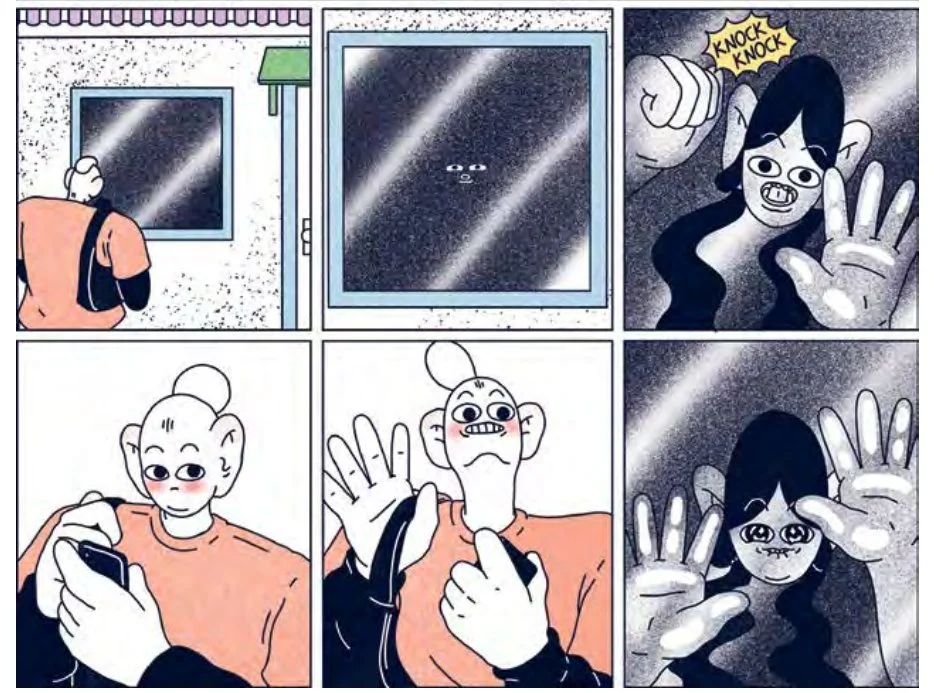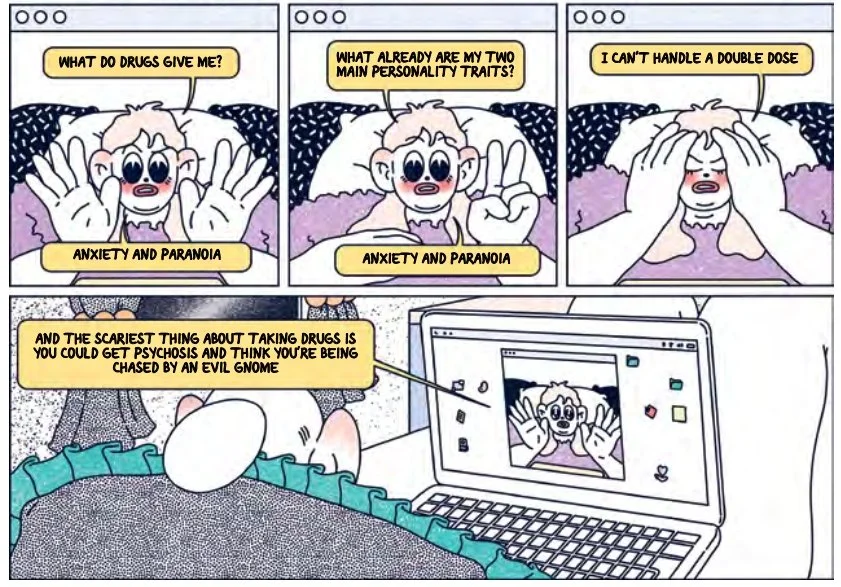REVIEW: Moa Romanova, “Buff Soul”
Cover, Buff Soul by Moa Romanova. Image Courtesy Fantagraphics.
REVIEW
Buff Soul
By Moa Romanova, Translated by Melissa Bowers
Hardback ($29.99)
Fantagraphics
By Cecilia Brown
Wearing hot pink sweatpants and an oversized black hoodie, Moa Romanova, the protagonist (and author) of the graphic novel Buff Soul, looks down at a folding table displaying three rifles, a handgun, and a pack of cigarettes. Moments before, she and her two best friends enter a shooting range in Texas where T-shirts with the slogan, “Freedom has a nice ring to it and a bit of a recoil” hang on a wall. On another wall is a decal that reads “We don’t call 911.” On her first try, one of Moa’s best friends, Lina, styled with bright pink hair and curtain bangs, strikes a lethal shot into the paper torso’s kidney. Throughout the novel, symbols of death and waves of grief haunt Moa as she travels from Sweden (her home country) to America. By exploring grief among such pithy humor and subtle political criticism, Buff Soul becomes an existentially jacked yet heartwarming graphic novel, especially for those in their late twenties seeking some food for the soul..
Buff Soul can be read as a graphic travel diary that delivers the plot one would expect when foreign rockstars play in Texas for the first time. Lina and Moa’s other best friend Asa are in a band called ShitKid, set to perform at SXSW, an annual media festival in Austin, Texas. Before the festival, Moa, who wants a break from the stress of making ends meet as a freelance artist, joins their couch surfing adventure in America to chill out and take life “damn easy” for a little while. Unexpectedly, memories involving Moa’s late friend Sofia pop up throughout the trip, turning what’s supposed to be a relaxing break into a week-long internal battle with herself. Moa struggles with how to feel better and with how to tell her best friends Asa and Lina about it.
Image Courtesy Fantagraphics
Romanova continues to explore the themes she has explored before in her past comics: characters torn between good and bad behavior, drugs and sobriety, isolation and partying. But in this contained, autobiographical story, Romanova makes the point of intrigue grief, examining how it distorts time, emotions, and thoughts as visceral as a drug trip. In doing so, she poses the questions: What does representing the impacts of grief through surreal meta-physical depictions, like flashbacks, do to our understanding of grief’s grip on our lives? How do friendships change and evolve for the better during times of grief?
Image Courtesy Fantagraphics
Buff Soul is Romanova’s third graphic novel. Broad shoulders, butt cheeks, platform leather boots, smartphones, electric guitars, lines of powder, glazed over eyes and giddy smiles fester these robust, pop-art-colored panels. Catchy, deadpan dialogue spews from the characters no matter how hungover or anxious or down they are. On facetime with her other best friend Sarah the night before her flight to LAX airport, Moas says, “I get all off-balance when [Asa’s] away, like a cat in a t-shirt.” Romanova handles silence between the characters by filling the panels with niche setting details and with excruciatingly precious and devastating facial expressions. With her usual deeply personal autofictional details and surreal representations of the body—peanut-sized heads and symbolic flesh that can dissolve between two panels—Romanova continues what she’s good at, gossip-like storytelling about the light and the dark.
Image Courtesy Fantagraphics
The love Moa has for her friends and Sofia, the friend whom she’s grieving throughout the book, further juxtaposes and elevates the story beyond the numerous “blows” Moa endures. At the end of the book, Asa reluctantly admits to taking “a lot of meth” with Dylan, the “hot as hell” musician she “sees” while in Austin. Moa groans in disapproval, but listens to and comforts Asa as she describes the horror movie-like experience. After Asa’s confession, Moa finally admits that she’s been thinking of Sofia a lot during the trip. Moa hesitates to say, “I didn’t think,” to which Asa finishes her thought, “you’d be afraid?” They attempt to understand each other’s choices and feelings, even if they don’t agree with each other or can’t relate to the pain they’re feeling. As Moa and Asa walk home after their confessions, they shyly tell each other, “you’re my person.” By the end of the chaotic trip, where they were mostly separated and overwhelmed by their own stressors, Moa and Asa turned the chaos into an opportunity to strengthen their friendship. As a result, the impulsive behavior of the characters and their insecurities are revealed to be caused by their contingent conditions: stress about the impossible pursuit to sustain themselves financially as artists, peer pressure to take certain drugs, being in a foreign country, and being plagued by grief. As impulsive as they are, Moa depicts her and her friends as ambitious, thoughtful, political, and selfless. Romanova shows that this duality coexists; it’s inescapable; it fluctuates; and it's sometimes painfully disorienting but has the possibility, if you work with it, to make you and your friendships stronger in the process.
Image Courtesy Fantagraphics
Buff Soul ends on an uplifting and witty note. After packing for her flight back to Sweden, Moa sits on the same porch that she fell down from. Her shoulders are slumped, and with bags under her eyes, she stares out at the nothingness happening across the street. Her host, Jeff, (who plays bass guitar for the Melvins) sits down next to her, after noticing her unsettling stillness. Jeff asks how she is. Moa says she’s fine. Determined to bring some relief to Moa, whether it’ll work or not, Jeff says, “I know you feel like shit.” Moa confirms with a, “Yeah.” Jeff continues, “But you’re not weak Moa. You might think you are. But you’re not. You’re just a thinker. And thinkers have buff souls.” Through this scene, Romanova reminds herself and readers of the admirable quality of thinking that can lose its confidence and creativity in the face of grief, Capitalism, relationship trouble, and drug use. Yet it’s a quality that can inspire friendship, art-making, and the desire to read stories unrelated to our own. In this way, the story’s message becomes explicit and comes full circle for Moa and for readers to examine. This scene invites us all to slow down and acknowledge something we may have forgotten—that we, like Moa, do indeed have a buff soul.
Like what you’re reading? Consider donating a few dollars to our writer’s fund and help us keep publishing every Monday.






